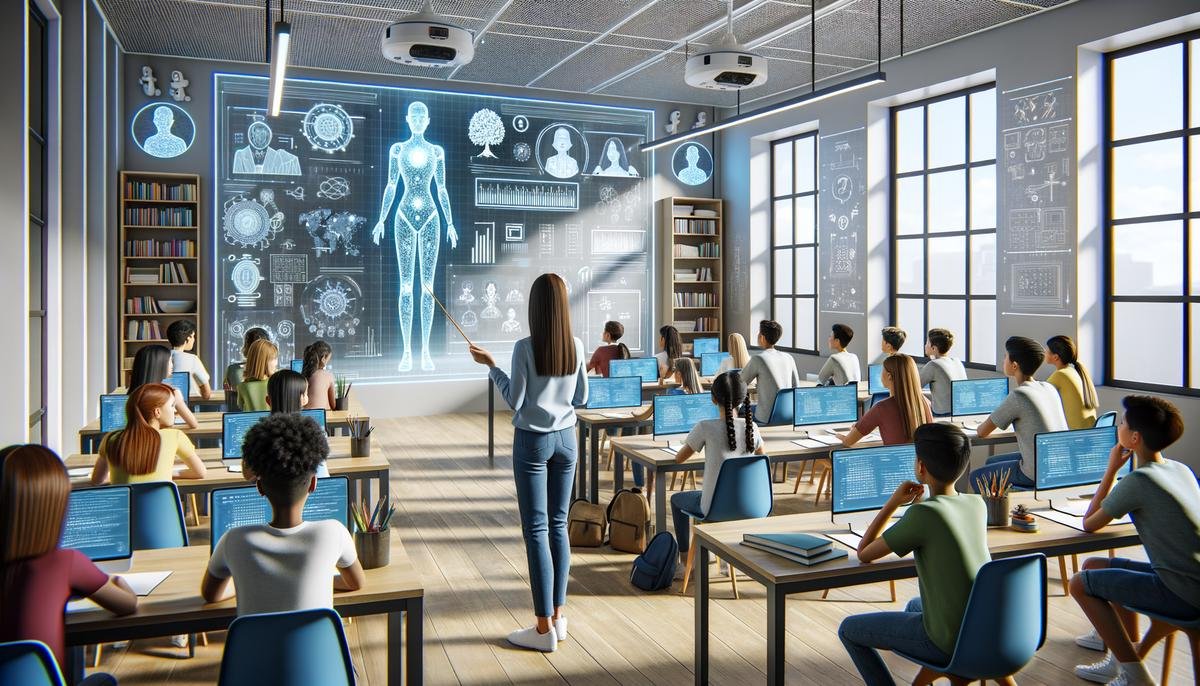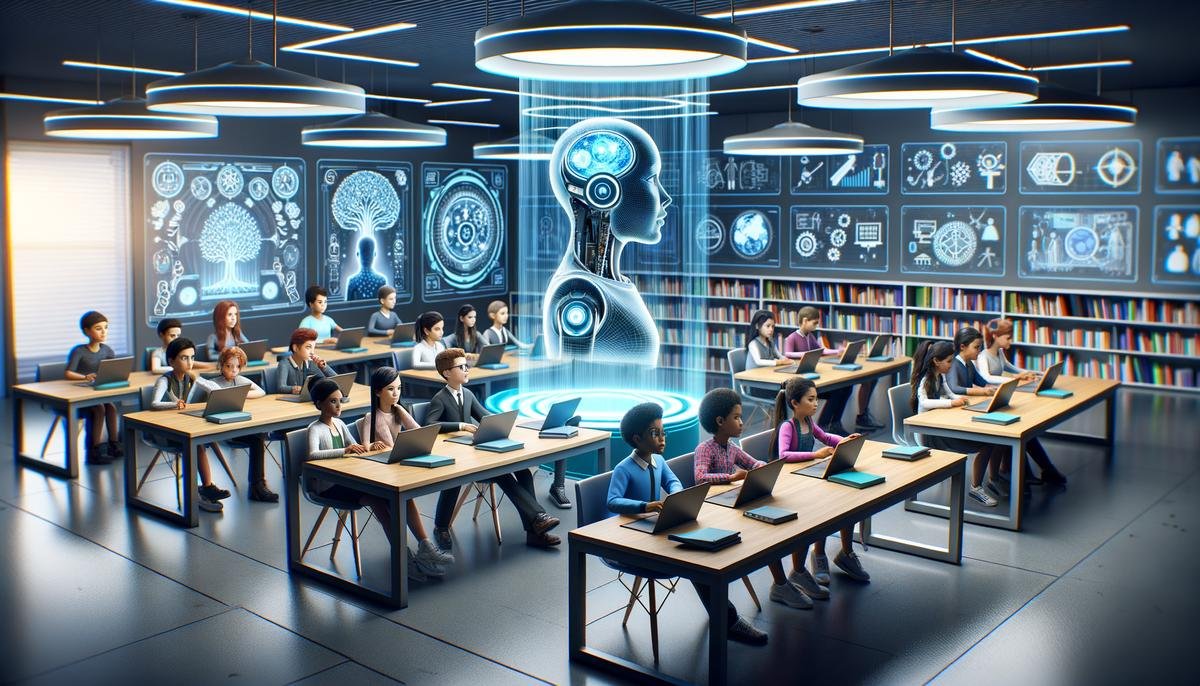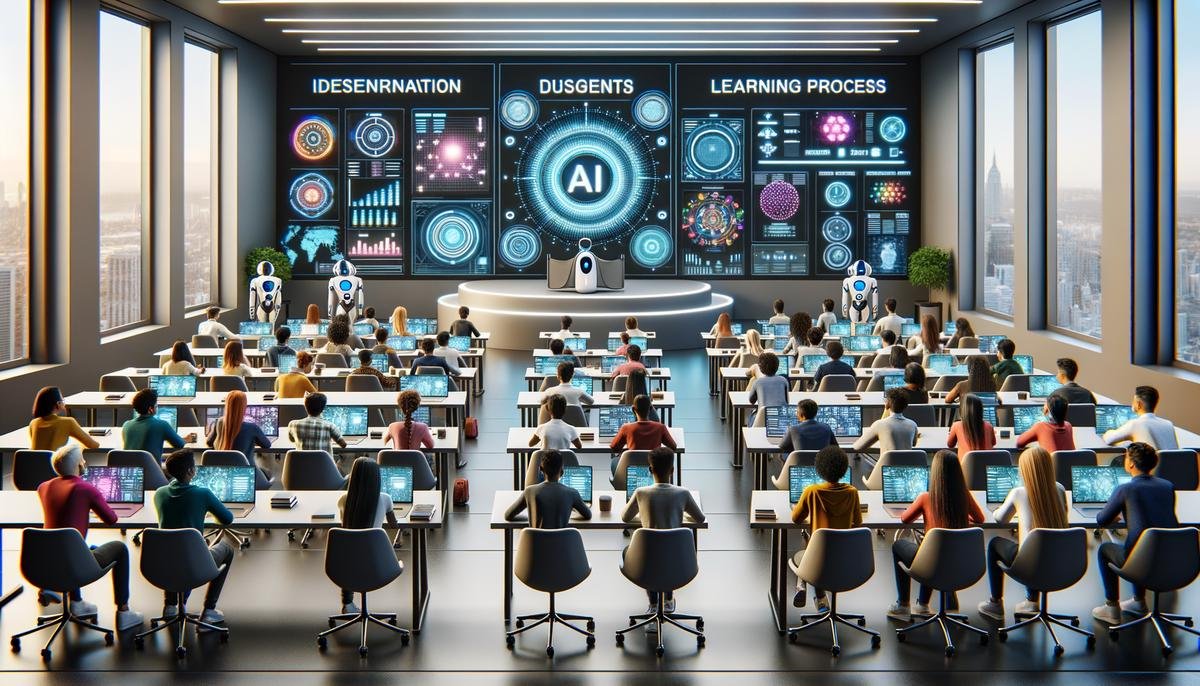Imagine a classroom where every student receives a learning experience tailored just for them, where teachers have more time to inspire rather than just instruct because of a helpful assistant that never gets tired. Welcome to the exciting world of artificial intelligence in modern education. This groundbreaking technology isn’t merely changing what we learn, but transforming how we learn it. From personalized study plans to smart systems that grade homework, AI is stepping up as a game changer in classrooms around the globe.
The Role of AI in Modern Education
AI is changing schools in a big way, making learning cooler and helping teachers, too. Imagine a classroom where computers can talk to you and help you with your homework, or where a robot can grade your test as soon as you finish. This isn’t just make-believe; it’s happening now because of artificial intelligence, or AI for short.
Teachers have lots of students, so sometimes it’s hard for them to give everyone the help they need. But AI can solve this problem. It can look at how each student learns and then suggest the best way for that student to study. It’s kind of like having a personal tutor that knows just what you need and when you need it.
And guess what? Tests and homework might not be so scary anymore because AI can change them to match how good you are at the subject. So, if you’re great at math, the problems get tougher, but if you’re still learning, they stay easier. That way, everyone can learn at their pace and not feel left out or bored.
But AI isn’t just about making learning different for each student; it also helps teachers. It can read through tons of essays super fast and check if there are any mistakes, which means teachers can spend more time teaching and less time grading. Plus, AI can see if someone isn’t doing well and let the teacher know so they can help them more.
When you learn a new language, AI can be your practice buddy. Programs powered by AI can listen to how you speak and correct your pronunciation, just like a real teacher. This way, you can practice talking in a new language without stressing about making mistakes in front of the class.
AI can also do super cool things like making virtual labs where you can do science experiments on the computer. You can mix chemicals or look at stars without even leaving your desk. It’s a safe and fun way to learn about science without needing a bunch of expensive equipment.
It’s not just schools that are changing because of AI. Even when you go home, AI can help you study with apps that remind you when it’s time to review and keep track of what you’re learning.
The most important thing is that AI makes learning more fun and less of a headache for everyone. With AI’s help, you can be better at school and get ready for a world full of technology.
So, the next time you’re in class or doing homework, remember that AI isn’t just a robot from a sci-fi movie. It’s a real tool that’s helping you and your teachers in amazing ways, right now.

Personalizing Learning with AI
In today’s digital age, artificial intelligence (AI) has snaked its way into almost every corner of our lives, and education is no stranger to its touch. The AI-integrated classroom, a space where technology and learning converge, has transformed the academic landscape, creating a myriad of opportunities for personalization that were barely imaginable a decade ago.
Within these techno-savvy classrooms, personalization is king. How does this royal treatment manifest? Every student receives individualized attention akin to a tailor-made suit. AI systems track and analyze the progress of learners, adjusting the difficulty and pace of the curriculum in real-time. These systems are intuitive, recognizing when a student is breezing through algebra and when another is grappling with the fundamentals of grammar. By catering to each student’s unique learning curve, AI ensures that no child is left behind, nor are they held back.
Moreover, the incorporation of AI stretches beyond typical classroom boundaries. Specialized learning platforms have emerged, ones that channel AI’s power to adapt content to suit varied learning styles. For the visual learner, a complex concept might transform into an infographic or a colorful animation. For the kinesthetic learner, interactive activities or games could take center stage.
AI also opens the door to a new realm of student autonomy. With tools like AI-driven organizers and planners, students can manage their own schedules and learning paths with greater independence. These nifty helpers prompt learners to set goals, track achievements, and identify areas in need of improvement.
Collaboration, a skill highly prized in both educational and professional settings, gets a digital upgrade as well. AI-integrated classrooms offer platforms where students can work together on projects, regardless of their physical location. These collaborative environments supported by AI provide real-time feedback and suggestions, enhancing the group’s overall productivity and learning experience.
For teachers, the burden of administrative tasks is lightened by AI’s heavy lifting. Educators are now freer to engage one-on-one with students, delve into creative teaching methods, and inspire a deeper connection with the material.
Above all, an AI-integrated classroom brings forth a customized learning journey. It’s akin to setting sail on the open sea with a compass that points not just north, but to your personal true north as an eager learner navigating the wide and wonderful world of knowledge. With such technology at the helm, education is not merely a transfer of information but an odyssey tailored to each learner’s pace, style, and aspirations. As we witness the dawn of this exciting epoch in education, one thing becomes crystal clear: in an AI-integrated classroom, learning is redefined.

Data Privacy and Ethical Considerations
Understanding the Data Privacy and Ethical Implications of AI in Education
Navigating the realm of education, AI’s incorporation into learning environments has sparked substantial dialogue about data privacy and the ethical use of technology. The use of AI systems in education necessitates the collection and analysis of vast amounts of student data, raising significant concerns.
Students’ data, including their learning patterns, preferences, and even their personal information, is often fed into AI algorithms to tailor educational experiences. This raises privacy issues as sensitive data could be exposed or misused. There’s a delicate balance between providing personalized learning and protecting individual privacy rights.
A paramount question involves the extent of data collection. It’s crucial to discern what data is necessary for AI systems to effectively enhance learning without overstepping into the realm of excessive surveillance. Missteps here could infringe on students’ privacy and autonomy.
Moreover, with AI-driven platforms, the potential for data breaches and unauthorized access to sensitive information looms large. It necessitates robust security protocols to ensure that student information is safeguarded against cyber threats. Schools and educational institutions bear the responsibility of implementing and updating these protective measures.
The ethical considerations also extend to the potential biases in AI algorithms. AI systems are only as unbiased as the data and the programming behind them. If an AI application is fed biased data, there’s a risk that it could reinforce existing inequalities, such as those based on race, gender, or socioeconomic status.
There’s also the moral obligation to prepare students for a future where AI is ubiquitous, which includes educating them about the importance of data privacy and ethical technology use. Teaching digital literacy becomes as crucial as reading and math skills in this new learning landscape.
Furthermore, the long-term impact of AI on the employment prospects for educators is a topic of concern. While AI can take over administrative tasks and provide supplemental instruction, it’s vital to consider how this shift will affect teaching roles. Ensuring that educators are trained to work alongside AI is key to smooth integration and maintenance of a healthy, human-centric learning environment.
As AI systems gain a foothold in education, a collaborative effort among policymakers, educators, and technologists is essential to address these privacy and ethical issues head-on. Establishing clear guidelines and maintaining an open dialogue will be pivotal in fostering an educational setting where AI serves as a supportive tool rather than a source of contention.
While AI promises a revolution in how education is delivered and received, it’s essential to proceed with caution, acknowledging the importance of students’ and educators’ rights and well-being in an increasingly data-driven world.

Overcoming Challenges in AI Implementation
Diving headlong into AI integration, schools encounter a myriad of challenges, not least the formidable cost factor. High-tech AI systems can deal a heavy blow to budgets, as schools must find funds for up-to-date hardware, software, and fast internet connections.
Another obstacle is teacher training – a critical yet complex issue. Even the most sophisticated AI programs falter without competent, confident instructors at the helm. Professional development, thus, becomes essential, imparting knowledge about AI operations and strategically embedding them into curricula.
Technical support is no small feat, either. Schools need round-the-clock IT assistance to prevent glitches from derailing digital learning. This requires additional, often scarce, human resources.
Even when the nuts and bolts are tightened, questions of efficacy remain. Can AI truly replace the nuanced guidance human teachers provide? Despite strides in educational technology, AI may lack the empathy and insight of an experienced educator, potentially leaving students with a one-dimensional learning experience.
Implementing AI equitably presents another hurdle. Disparities in resources can widen the education gap, placing underserved communities at a disadvantage. Ensuring that every student benefits from AI-driven education demands concerted, collaborative efforts from all stakeholders.
Now, overcoming these obstacles is far from insurmountable; it just takes a tad of ingenuity and planning. Cost issues can be addressed through creative financing, such as grants, partnerships with tech companies, and staggered implementations to spread out expenses.
Professional development can be reimagined to include hands-on workshops, online courses, and learning communities. Teachers can share AI integration strategies, fostering a culture where teaching with tech becomes second nature.
As for technical support, schools might consider partnering with local colleges, harnessing the know-how of tech-savvy students, or training in-house “AI champions” to offer peer-to-peer assistance.
To match AI’s logic with human touch, schools can adopt blended learning models. By combining AI tools with traditional teaching methods, educators can offer data-driven insights while preserving the personal connection that remains at the core of effective teaching.
Addressing equity, schools could pool resources, advocate for broadband access in rural and underserved areas, and ensure that AI tools are culturally responsive and accessible to all learners.
In sum, while AI’s integration into education isn’t without its fair share of hurdles, a proactive, thoughtful approach can lead to transformative outcomes – where every learner benefits from technology tailored to elevate their academic journey.

The Future of AI and Education
Delving into the possibilities at the horizon of artificial intelligence (AI) and education, there’s fertile ground for innovations that could redefine how learning unfolds. In the future, classrooms might resonate with the hum of advanced AI capabilities, elevating the educational experience in unprecedented ways.
The steady evolution of AI opens doors to ‘smart’ classrooms where the environment itself adapts to foster immersive learning. Imagine walls doubling as interactive surfaces, responding to students’ questions, or AI-guided modules that transform a math lesson into a gripping quest involving problem-solving in a virtual world. It’s about creating a dynamic educational context that breaks free from one-size-fits-all pedagogy.
As AI systems continue to gain sophistication, the role of educator could be augmented significantly. Teachers, equipped with AI tools, today might analyze student writing to tailor feedback, but the AI of tomorrow might coach educators to refine their own teaching methods. It’s like having a personal professional development assistant, one that offers insight into how to make a bigger educational impact.
Then there’s the prospect of globally connected classrooms. AI, coupled with advancements in translation and communication technology, could dissolve language barriers, bringing together students from various corners of the world for interactive learning experiences. This instant exchange of knowledge and cultural wisdom could foster a generation of global citizens, at ease with the diversity that defines human society.
Equity remains a vital consideration as AI systems become more entrenched in education. The future holds the promise of AI-driven initiatives focused on making high-quality education borderless and inclusive. We could see a world where AI supports remote villages to access the same level of education as a student in a technologically advanced metropolis, leveling the playing field in profound ways.
Furthermore, as lifelong learning becomes a necessary pursuit in a rapidly changing job market, AI is poised to be the linchpin for continuous education. Adult learners could benefit from AI platforms designed to update their skills, aligned with evolving industry demands and personal career trajectories. It’s a system where education doesn’t end with graduation; rather it becomes an adaptable journey aligned with an individual’s life stages.
Among the future advancements, ethical AI stands out as a central theme. As educators lean more on these technologies, there’s a pressing need for ethical frameworks that ensure AI in education respects and nurtures the human experience. Developing AI with empathy—understanding the nuances of human emotions and the importance of ethical considerations—could become the cornerstone of educational AI applications.
The integration of AI in education could further branch into the realm of augmented reality (AR) and virtual reality (VR). Beyond simulations, these technologies can evolve to offer experiential learning where students embark on historical explorations, or deep-sea dives, in a controlled, AI-augmented reality space. The result is an evocative, sensory-rich educational experience that could dramatically enhance retention and understanding of complex subjects.
The prospects for AI in education also extend to novel assessment methods. AI could go beyond adaptive testing to provide real-time, continuous assessment patterns, akin to a GPS for learning—constantly recalibrating to provide the most efficient learning path for each student. These advanced systems could identify gaps in knowledge before they widen, offering corrective measures on the fly.
Ultimately, the future of AI in education aims to cultivate a rich soil where the seeds of curiosity can grow unfettered. It’s about nurturing a love for learning, emboldened by technologies that understand and amplify human potential. As we venture forward, the intersections of AI and education may well be the compass that guides us to a future where learning is limitless, accessible, and profoundly human at its core.
In the dynamic interplay of technology and pedagogy, the possibilities seem boundless. What’s crucial is that as society steps into this new era, it does so with careful consideration, ensuring that the trajectory of AI in education charts a course that uplifts, empowers, and respects every learner and educator it touches. With each byte and algorithm, AI in education is poised to redefine what it means to learn, teaching us about the world, ourselves, and the boundless potential of the human spirit when paired with the intelligence of machines.

As we gaze ahead into the not-so-distant future, the potential of artificial intelligence in education stretches further than the mind can see. It promises a world where learning is not just custom-fit to each student’s strengths and weaknesses but also continuously adapting to their evolving needs. With careful attention to preserving data privacy and ethical standards, the educational journey with AI appears filled with possibilities, exciting challenges, and a horizon that hints at an even smarter generation of learners and educators.




